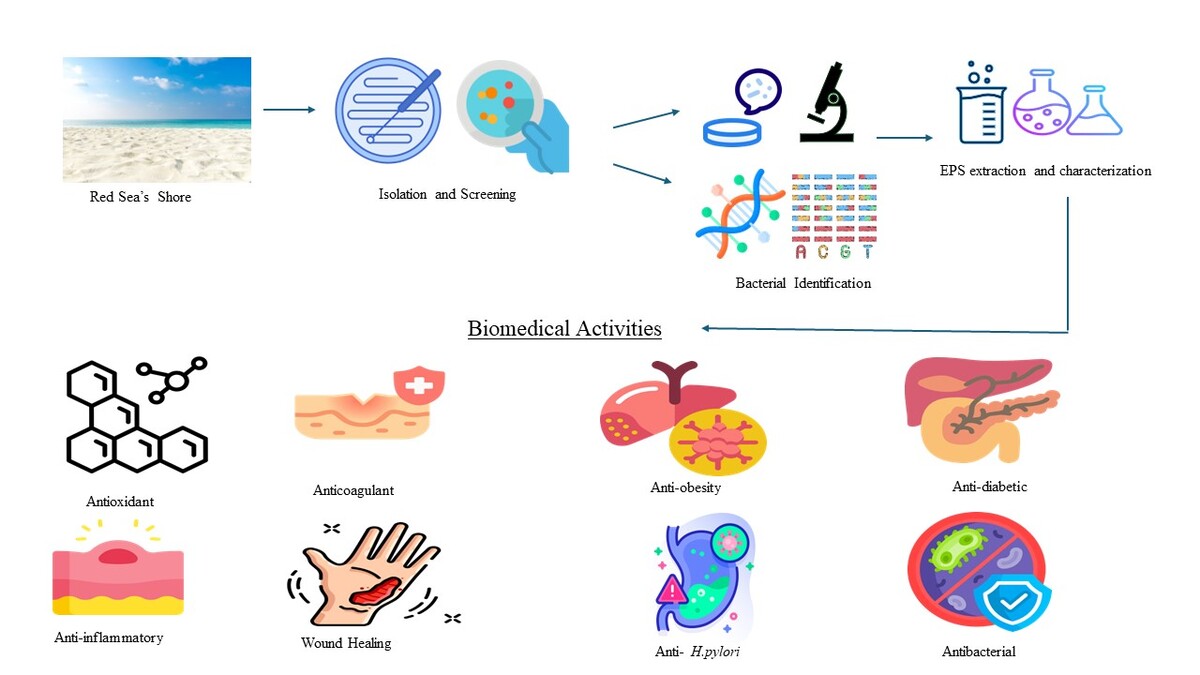Current issue
Archive
Manuscripts accepted
About the Journal
Editorial office
Editorial board
Section Editors
Abstracting and indexing
Subscription
Contact
Ethical standards and procedures
Most read articles
Instructions for authors
Article Processing Charge (APC)
Regulations of paying article processing charge (APC)
RESEARCH PAPER
Investigating the Multi-Targeted Pharmacological profile of an Exopolysaccharide from Bacillus rugosus SYG20 via In Vitro Evaluation of its Antioxidant, Anti-inflammatory, Anti-diabetic, Wound Healing, and Antimicrobial Properties
1
Department of Biology, College of Science, Princess Nourah Bint Abdulrahman University, P.O. Box 84428, Riyadh 11671, Saudi Arabia, Saudi Arabia
2
Medical lab technology department, faculty of Medical technology, Wadi-Al-Shatii University, Brack, Libya, Libya
3
Department of Biological Sciences, Faculty of Science, King Abdulaziz University, Jeddah 21589, Saudi Arabia, Saudi Arabia
4
Laboratory and Blood Bank department, Prince Sultan Military Armed Forces, Madinah, Saudi Arabia;, Saudi Arabia
5
5 College of Applied Medical Sciences, Prince Sattam Bin Abdulaziz University, Al-Kharj 11942, Saudi Arabia, Saudi Arabia
6
Department of Basic Medical Sciences, College of Medicine, AlMaarefa University, Diriyah, 13713, Riyadh, Saudi Arabia, Saudi Arabia
7
Department of Medical Microbiology, Faculty of Medicine, University of Tabuk, Tabuk 71491, Saudi Arabia, Saudi Arabia
8
Microbiology and Immunology Department, Faculty of Pharmacy, Egyptian Russian University11829, Cairo, Egypt, Egypt
9
Department of Clinical Microbiology and Immunology, Faculty of Medicine, King Abdulaziz University, Jeddah, Saudi Arabia, Saudi Arabia
10
Botany and Microbiology Department, Faculty of Science, Suez Canal University, Ismailia 41522, Egypt;, Egypt
Submission date: 2024-02-10
Final revision date: 2024-05-22
Acceptance date: 2024-06-13
Online publication date: 2024-07-03
Corresponding author
Ahmed Ghareeb
Botany and Microbiology Department, Faculty of Science, Suez Canal University, Ismailia 41522, Egypt;, Egypt
Botany and Microbiology Department, Faculty of Science, Suez Canal University, Ismailia 41522, Egypt;, Egypt
KEYWORDS
TOPICS
ABSTRACT
Introduction:
Exopolysaccharides (EPSs) derived from marine microorganisms are a newly recognized reservoir of bioactive therapeutic compounds
Material and methods:
We isolated a high EPS-yielding bacterial strain from the Red Sea, identified as Bacillus rugosus SYG20. Its purified EPS (EPSR9) contains 45.33% uronic acid, 9.98% sulfate groups, and 5.40% N-acetyl glucosamine. The HPLC chromatogram revealed four monosaccharides - glucose, xylose, galacturonic acid, and arabinose, in a distinct molar ratio of 2:3:1:1. EPSR9 showed a wide array of bioactivities.
Results:
It displayed antioxidant activity with an IC50 of 25.6 μg/ml in the DPPH assay and a total antioxidant capacity (TAC) of 417.77μg/ml equivalent AAE and 62.67 μg/ml equivalent AAE in Ferric reducing antioxidant power (FRAP) assays. It exhibited substantial anti-inflammatory properties. The anticoagulant effect of the EPS was demonstrated by a dose-dependent increase in prothrombin time. The scratch assay resulted in a 72.66% increase in wound closure, promoting in vitro wound healing after 48 h. Anti-obesity activity was evidenced by 83.8% lipase inhibition at 1000 μg/ml with IC50 of 107.73μg/ml. EPSR9 demonstrated inhibitory effects on α-amylase with an IC50 value of 14.37μg/ml and α-glucosidase with an IC50 value of 26.73 μg/ml, highlighting its potential as an anti-diabetic agent. Then, EPS showed bactericidal properties with MBC/MIC≤2 against both G+ve and G-ve bacteria, Staphylococcus aureus , Enterococcus faecalis (MIC=3.9μg/ml), Salmonella typhi, and Helicobacter pylori.
Conclusions:
The marine EPSR9 exhibited considerable potential for pharmaceutical applications as a multi-bioactive microbial metabolite. Its in vivo potency and mechanisms of action warrant further investigation.
Exopolysaccharides (EPSs) derived from marine microorganisms are a newly recognized reservoir of bioactive therapeutic compounds
Material and methods:
We isolated a high EPS-yielding bacterial strain from the Red Sea, identified as Bacillus rugosus SYG20. Its purified EPS (EPSR9) contains 45.33% uronic acid, 9.98% sulfate groups, and 5.40% N-acetyl glucosamine. The HPLC chromatogram revealed four monosaccharides - glucose, xylose, galacturonic acid, and arabinose, in a distinct molar ratio of 2:3:1:1. EPSR9 showed a wide array of bioactivities.
Results:
It displayed antioxidant activity with an IC50 of 25.6 μg/ml in the DPPH assay and a total antioxidant capacity (TAC) of 417.77μg/ml equivalent AAE and 62.67 μg/ml equivalent AAE in Ferric reducing antioxidant power (FRAP) assays. It exhibited substantial anti-inflammatory properties. The anticoagulant effect of the EPS was demonstrated by a dose-dependent increase in prothrombin time. The scratch assay resulted in a 72.66% increase in wound closure, promoting in vitro wound healing after 48 h. Anti-obesity activity was evidenced by 83.8% lipase inhibition at 1000 μg/ml with IC50 of 107.73μg/ml. EPSR9 demonstrated inhibitory effects on α-amylase with an IC50 value of 14.37μg/ml and α-glucosidase with an IC50 value of 26.73 μg/ml, highlighting its potential as an anti-diabetic agent. Then, EPS showed bactericidal properties with MBC/MIC≤2 against both G+ve and G-ve bacteria, Staphylococcus aureus , Enterococcus faecalis (MIC=3.9μg/ml), Salmonella typhi, and Helicobacter pylori.
Conclusions:
The marine EPSR9 exhibited considerable potential for pharmaceutical applications as a multi-bioactive microbial metabolite. Its in vivo potency and mechanisms of action warrant further investigation.
Share
RELATED ARTICLE



